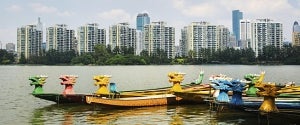
Today, a little more than half of China’s population is urbanized. As expected and planned by the country’s leaders, over the next decade, the urbanization will continue at the current pace. In 2025, 70% of Chinese people are expected to live in cities of more than one million inhabitants. This massive and rapid migration will have various consequences, one of which is the need for transport between cities, and also within them.
In 2011, the Chinese State Council approved 34 cities to build their own metro network and subsequently, 2,000km of metro lines are now under construction. To ensure a high level of security and to ensure efficient use of the metro lines, advanced traffic signal control solutions are used, such as communication-based train control (CBTC). At least half of the metro lines built in China between 2011 and 2015 are or will be equipped with a CBTC system. CBTC systems rely on continuous wireless communication between antennas located on or in the train and other antennas, placed along the metro line.
1,000 HUBER+SUHNER CBTC antennas in Nanjing Metro
The HUBER+SUHNER Sencity® antenna family has been specially developed for this application and comprises products for use on the train, as well as on the trackside. The antennas fulfil all of the relevant metro standards and also guarantee the expected performance and reliability of a CBTC system over its lifetime of ten to 30 years. In 2013, one of the most advanced providers of railway and urban rail traffic signal control solutions in China selected the HUBER+SUHNER Sencity Spot-M Yagi antenna.
More than 1,000 pieces are used on the trackside of one of the Nanjing Metro lines, connecting Nanjing center with one if its satellite suburbs, which is over 40km long and has 17 stations. It started running in January, just before the beginning of the 2014 Youth Olympic Games hosted in Nanjing.
Advantage of global transfer
This success of HUBER+SUHNER with Sencity antennas in the Chinese transportation market is the heritage of a lot of experience and know-how accumulated globally and now transferred to China. For the Nanjing project, various technical meetings and seminars took place in China with the customer, involving experts from HUBER+SUHNER Switzerland.
Several documents, such as detailed test reports and references, also had to be delivered to demonstrate the uniqueness of the product design and its reliability over time. This project is a good example of what is possible when intensive local efforts are combined with experience and strong support from other parts of the world.
As a global company, HUBER+SUHNER could take advantage of this and transfer its experience from both Switzerland and France to China. This collaborative effort, combined with expected development of the Chinese transportation market, means HUBER+SUHNER is expecting to equip many more Chinese railway lines with its antennas in the near future.
For more information, please contact HUBER+SUHNER.
